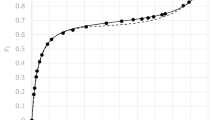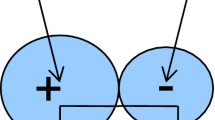Abstract
Pitzer's ion interaction model has been widely accepted for calculating the thermodynamic properties for electrolytes at high ionic strength. For weak electrolytes, a better estimation can be obtained by combining the model with chemical equilibria. The method of calculation is to treat each individual species as a single, separated ion. The concentration of each ion will be constrained by the mass balance equation and its activity will be guarded by the stability constants. Including chemical equilibria in Pitzer's model provides not only a better estimation of the thermodynamic properties of weak electrolytes but also a better understanding of the equilibrium among the complexes. The results may be used for correcting the effect from high ionic strength solution when determining the stability constants. When considering chemical equilibria, some of the parameters reported by Pitzer may have to be reestimated. The method of estimation and comparison between final results are presented. The binary system of HF, and the ternary systems of CuCl2 in NaCl and in HCl are used for demonstration.
Similar content being viewed by others
References
K. S. Pitzer,Activity Coefficients in Electrolyte Solution (CRC Press, Boca Raton, 1979).
C. E. Harvie, N. Moller, and J. H. Weare,Geochimica et Cosmochimica Acta 48, 723 (1984).
K. S. Pitzer and L. F. Silvester,J. Solution Chem. 5, 269 (1976).
K. S. Pitzer, R. N. Roy, and L. F. Silvester,J. Am. Chem. Soc. 99, 4930 (1977).
E. Hogfeldt,Stability Constants of Metal-Ion complexes: Part A Inorganic Ligands (Pergamon Press, London, 1982).
J. Bjerrum and L. H. Skibsted,Acta Chem. Scan. 31, 673 (1977).
B. R. Staples,et al., NBS Special Publication 718 (1986).
C. J. Downes and K. S. Pitzer,J. Solution Chem. 5, 389, (1976).
D. M. Himmelblau,Process Analysis by Statistical Methods (Wiley, New York, 1968).
J. L. Kuester and J. H. Mize,Optimization Techniques with Fortran (McGraw-Hill, New York, 1973).
H. H. Borene and T. D. Vries,J. Am. Chem. Soc. 69, 1644 (1947).
W. J. Hamer and Y. C. Wu,J. Phys. Chem. Ref. Data 1, 1047 (1972).
P. McTigue, T. A. O'Donnell, and B. Verity,Aust. J. Chem. 38, 1797 (1985).
J. J. Fritz,J. Phys. Chem. 84, 2241 (1980).
V. K. Filippov, N. A. Charykov, and Y. A. Fedorov,Zhur. Neorg. Khim. 31, 1861 (1986).
R. N. Goldberg,J. Phys. Chem. Ref. Data 8, 1015 (1979).
R. Nasanen,Acta Chem. Scan. 4, 140 (1950).
Y. Awakura, Y. Kawasaki, A. Uno, K. Sato, and H. Majima,Hydrometallurgy 19, 137 (1987).
Author information
Authors and Affiliations
Rights and permissions
About this article
Cite this article
Haung, HH. Estimation of Pitzer's ion interaction parameters for electrolytes involved in complex formation using a chemical equilibrium model. J Solution Chem 18, 1069–1084 (1989). https://doi.org/10.1007/BF00647264
Received:
Revised:
Issue Date:
DOI: https://doi.org/10.1007/BF00647264




